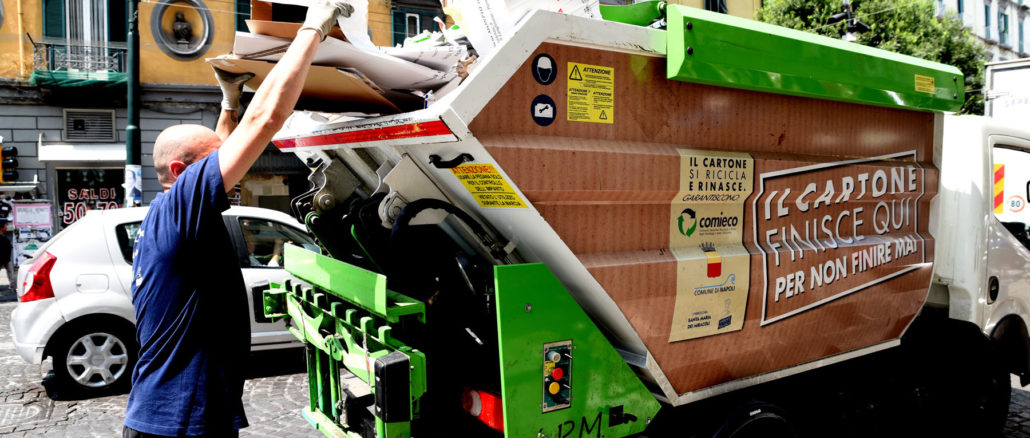
We talked about Rione Sanità’s experiment with Roberto Di Molfetta, who highlighted both good and bad points of this experiment.
How was Rione Sanità’s cardboard collection project created?
It is a project born out of a need to find methods of increasing cardboard collection in the most problematic city centres but with a huge collection potential: we thought about an experiment in Rione Sanità where we found a welcoming and fertile fabric of society and the enthusiastic support of Tommaso Sodano, the then Naples’ deputy mayor. And this is how we were able to start this experiment which lasted 6-8 months. Since Naples already had an agreement with ASIA within the ANCI-CONAI contract, we developed a specific agreement for the experiment in Rione Sanità.
What’s your target for this experiment?
Our target is to locate both retailers and production sources generating cardboard as waste. But we also intended to fathom the possibility of developing a widespread collection service which could go further than ASIA’s in an area where geography and the low involvement of users represent a real problem. In doing so, we made sure that our experiment did not overlap with ASIA’s service but rather integrated it.
What about the social aspect?
Rione Sanità’s experiment was also characterized by the fact of going beyond the environment embracing social targets, that is enabling disadvantaged people from the neighbourhood to find a way to make a living. On this front, Alex Zantonelli’s Rete Sanità and Father Valentino De Angelis’s Santa Maria dei Miracoli Parish were crucial.
Could you give us a general overview of the results achieved so far?
Yes. It has been an experiment with both positive and negative points from which we have learned a great deal. On the one hand, we saw an increase in cardboard collection with the participation of people who had not got involved previously. And now the experiment is being expanded to a bigger area through ASIA’s call for tenders partly created thanks to this experiment. The most difficult part was to find an optimal area, big enough to balance the accounts. Finally, in Rione Sanità it would have been useful to have a larger vehicle that, together with the small one, would drive through the narrow lanes in order to increase quantities while containing costs.
What is the difference between this type of collection and the traditional one?
The difference is huge. We went from the collection of cardboard left near un-separated waste to a collection tailored to the needs of each user. It must be highlighted that ASIA, in order to assess this method in a bigger area, got Arcobaleno involved, a cooperative from Turin and pioneer in Italy in the applied social cooperation in the separate collection sector, to carry out in collaboration with a local cooperative another experiment in a different area of Naples. In this case, the experiment also proved successful. ASIA reduced its costs while increasing collection.
Comieco has got plans for Southern Italy. Do you think you will use this experience?
Yes. We believe that a series of aspects of this experience can be used in our project for Southern Italy, which involves the funding of means and vehicles. We envisage that in Southern Italy collection can be doubled, from 624,000 tonnes collected every year to 1.3 million tonnes. In Naples, for instance, we think we can exceed 40,000 tonnes in a short period of time, starting from 30,000 tonnes in 2014. Naples’ collection potential varies between 60 to 70,000 tonnes, improving paper collection both at family and office level and cardboard collection across the board.
So do you think that this experiment can be replicated?
We think so. The Municipality of Naples’ call for tenders for the collection of cardboard involving about half of its territory draws a lot on Naples’s cooperative experiment. All areas with logistic problems are suitable, but other factors must also be taken into consideration. Local authorities must be interested in developing this kind of service and the optimization of the service must be carefully assessed as well as the disappearing costs linked to the subtraction of cardboard from the un-separated waste flow. Moreover, we must use resources deeply rooted at local level with specific know-how. Improvising is out of the question.
Could Rome, with its historical centre, be a test bed?
Some time ago, we presented our detailed plan for cardboard collection to Ama (Rome’s Public Utility) and we are still waiting. Ama is still not able to locate all the cardboard available. We need a different type of service, much more widespread and able to make use of innovative methods such as, for example, retailers’ indication of cardboard availability.
Info
www.ambientesolidale.it
www.comieco.org

Lascia un commento